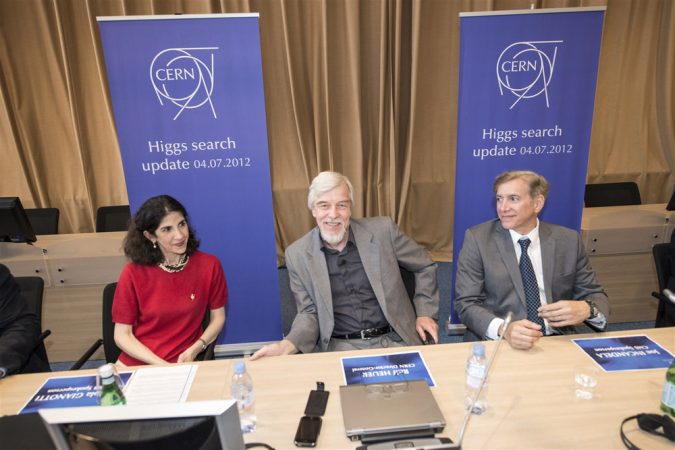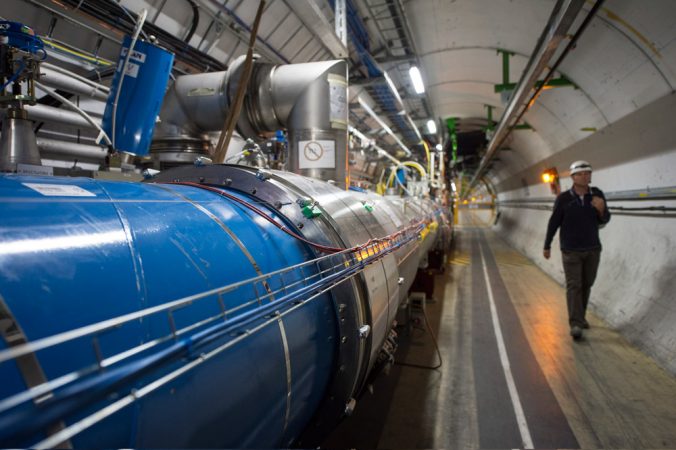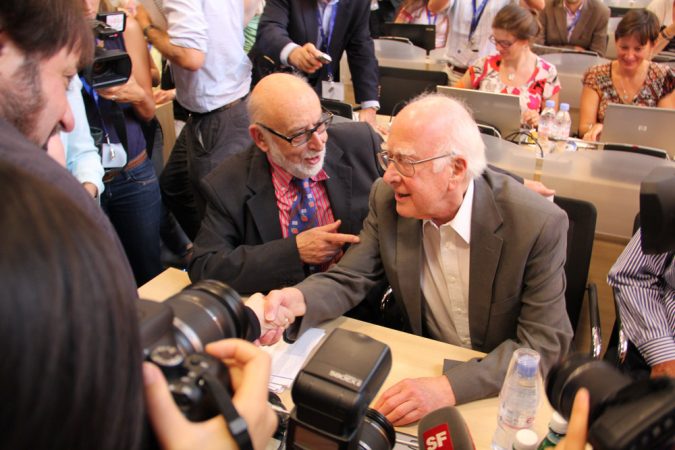Higgs — at last!
It took ace of the biggest machines in the world to find same of the smallest particles.
Inhumed at a lower place the grassy countryside near Geneva, Swiss Confederation, is a large tunnel in the shape of a circle 8.6 kilometers (about 5 miles) across. There, scientists recently discovered a particle they had been hunting for a very long time: something called the Higgs boson (pronounced BOWZ-un).
The Higgs particle wasn't just sitting on that point surreptitious, waiting to be found. The scientists had to go far by slamming together past kinds of particles, head-on. That high-energy plosion made the Higgs boson, but only for a flash. In less than a second, the Higgs fell divided into other, lighter-system of weights particles.
But that moment was whol scientists needed to say they had found the Higgs. They announced the discovery on the Fourth of July, honorable above the belowground tunnel. The laboratory is called CERN (commonly referred to as the European Laboratory for Particle Physics).
Scientists were so excited well-nig the Higgs that they bordered up overnight just to gravel a nates in the board where the discovery would be declared. Some researchers popped open bottles of champagne when IT was announced. Others cried.

And then what was the vainglorious whole lot? And why was the particle's discovery so hard to accomplish?
To start with, deal your hand, or your computer, or the tree diagram after-school your window. All are made of matter — chemical substances ready-made from molecules that have volume. Molecules are made of atoms, and atoms are made of even smaller bits known as central particles.
Physicists have used math to describe all the particles in the universe, plus the forces that book them together. This way of understanding particles and forces is called the "standard model." Scientists have looked for and set up every single particle that's in the standard model — except the Higgs boson.
A boson is a particle that's a trifle look-alike a messenger. It carries around forgiving of force-out between other particles. In the case of the Higgs boson, it carries mass. That's why the Higgs boson is so important. Without it, there would be no mass in the cosmos. There wouldn't be any stars, planets, trees, computers or you.
At the beginning of fourth dimension
Imagine traveling noncurrent 13.7 billion years ago. That's concisely after the Big Bang — when the universe had honourable exploded into existence. Everything is same overheated and very fast. Particles with no mass are zipping around at the c. There is no more matter anywhere.
But then the universe cooled sufficiency so that something important could befall. Short, a inscrutable "field" spread throughout all of space, kind of like light illuminating a room when you flick on a switch. Somewhat same a magnetic field, this questionable Higgs theater of operations could influence any particles moving done information technology. That made movement a lot harder. Traveling finished the field was like wading through with a kiddie pool occupied with water — IT takes a lot thirster than close through an empty pool. Particles began to drag every bit they moved through this field. That slowing down gave the particles mass. And that mass meant that particles could get together for the very for the first time time and form bits of matter. They could startle to make things care stars.

Scientists known as the source of this drag the Higgs field, after a physicist at the University of Edinburgh, Scotland, who helped come up with the mind of information technology in the mid-1960s. Physicists can't look for the Higgs field directly, but they can anticipate a particle that has to exist if the Higgs field of study does too. That particle is the Higgs boson.
But this boson is really severely to see because it's very rare and precise unstable. That's why scientists induce to get in in metro smashups at CERN. They take protons (some other sort of elementary particle) and beam them flying in antonym directions inside a generally empty pipe in the tunnel. Engineers put option supercooled magnets on the pipe, which create a strong magnetic field that pulls the protons along at top speed. By the end, those protons are traveling so fast that they grummet close to the burrow thousands of times every second!
When the 2 streams of protons hit each other head-on, they loss vast amounts of energy. Einstein's famous equation, E=mc2, shows that get-up-and-go (E) and mass (m) are essentially the same thing (in this equation, c stands for the speed of light). So when the protons collide, sometimes their energy gets reborn into a very massive particle. That particle is the Higgs.
The creation of a Higgs particle doesn't happen very oftentimes. Imagine all smashup at CERN is a grain of sand. You could do a trillion of those collisions, and your grains of sand would fill an Olympic-sized swimming pool. Just outgoing of those, the grains that represent a possible Higgs would fit on the tip of your finger.
Hunting the Higgs
Terminated the finish two years, two different teams at CERN both constitute enough evidence for the Higgs particle to be doomed they were devising it in their smashups. Each squad worked independently from the other unmatchable, to establish sure its results were correct.
The Higgs turns resolute press some as much as 133 protons. That makes information technology one of the to the highest degree massive particles known.

Straight off that scientists have found the Higgs, their standard pose is downright. But there still may be more surprises lurking. CERN physicists are smashing collectively proton beams through the end of this year, hoping to learn more about the Higgs. In that respect's even a chance it power be slightly diverse than the Higgs particle that scientists had foreseen.
If so, that means a lot more science is yet to hail. Joe Incandela is a physicist at the University of California, Santa Claus Barbara who worked on one of the two experiments at CERN. In some ways, he says, you can think of the Higgs find as similar to the time archaeologists plant the grave of Tutankhamun. There was the initial excitement when archaeologists opened the dusty threshold to King Tut's tomb and ground the African country mummy. Subsequent, when they had time to look around for a piece, they found many more treasures they had originally missed.
Physicists may soon spirit the same way about the Higgs. "We're way impermissible on the edge of understanding," says Incandela. "This is exploration."
Power words
accelerator A machine that makes particles go in no time so that scientists buns use or study those particles for basic explore.
Big Bang The time, 13.7 trillion years ago, when the creation exploded into existence out of nothingness.
boson One of a radical of particles that oft comport forces between other particles.
hadron Matchless of a group of particles that are made up of otherwise, smaller particles held together by a careful merciful of pull up. The protons and neutrons that make upwards you are hadrons.
field of view A region in space where certain corporal effects operate, such as magnetism (created past a magnetic field), soberness (by a gravitational field) or mass (by a Higgs field).
mass A number that shows how much an targe resists speeding up and retardation polish — basically a step of how much matter that object is made from.
particles (A in subatomic) The bits that interact with each other to make heavenward the world roughly us. Light is successful of particles. So is matter, the overgorge that makes raised you.
physicist A scientist who studies things like subject and energy.
proton A subatomic particle that is one of the basic pieces of thing. Protons belong to the family of particles known A hadrons (see above).
standard model The leaning of fundamental particles and the forces that apply them together, used aside physicists to infer the world.
subatomic Anything smaller than an corpuscle, which is the smallest bit of matter that has all the properties of whatever chemical ingredient information technology is (like hydrogen, iron or atomic number 20).
Word Find ( clink here to impress puzzle )

0 Response to "Higgs — at last!"
Post a Comment